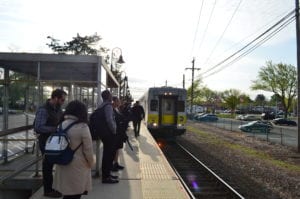LIRR to develop plans for electrifying Port Jefferson and central branches

The electrification of the Long Island Rail Road’s Port Jefferson Branch is back on the table, and government officials say they’re optimistic about the prospect, since now there’s some money to fund the idea.
New York State Sen. Jim Gaughran (D-Northport) during an informal interview May 9 at the Huntington train station, where he was personally handing out commuter surveys, said he predicts that the line will become fully electrified within the next five years.

“It’s been talked about for decades,” he said. “It’s time to make it happen.”
Currently, the branch east of Huntington uses diesel or double-decker, dual-fuel trains, that are prohibited in Manhattan. Commuters between New York City and points east of Huntington on the Port Jefferson Branch must change from diesel to electric trains, or vice versa for the reverse commute, at various junctions, typically in Huntington. The process is time consuming and inconvenient for passengers, who are often subject to inclement weather on an open platform. Electric trains would eliminate the need to change trains and would create a time-saving, one-seat ride to Manhattan.
Gaughran, who is serving his first term in the state Senate, has been a major proponent of the MTA Rail Act, an overhaul plan, which Gov. Andrew Cuomo (D) signed into law last month. New York State’s 2019-20 budget funds the overhaul and includes an expected $1.5 billion in capital projects for the Long Island Rail Road. Funds will be used for a variety of needs, but new trains and increased service are top priorities, according to Gaughran’s office.
Electrification makes sense now, Gaughran said, because it would help address both congestion at Huntington’s station, which serves 41,440 daily weekday riders, while speeding up the slow commute to New York City.
Gaughran said that he’s already taken steps to advocate for electrification. He’s also conducted mobile town halls on trains during the morning commute to solicit passenger input on all rail service issues and will present passengers comments from his surveys to railroad officials later this year.
Details from the Long Island Rail Road
The LIRR is currently evaluating proposals, according to its spokesperson, and will soon award contracts to begin the electrification studies for both the Port Jefferson Branch and the Central Branch, which connects Babylon to Hicksville via Bethpage. The studies will determine what is required to complete each project.
Overall, the electrification project, in addition to a new fleet, would require significant investments in infrastructure such as new substations, a third rail and a second track between Huntington and Port Jefferson, upgrades to half-dozen platforms and work on bridges, viaducts and crossings, according to LIRR’s spokesperson. Additional train storage yard(s) will also be needed.
The railroad does not yet have funding for construction but is seeking it for the Central Branch electrification in its 2020-24 capital program. Port Jefferson electrification would require additional funding in several other future programs.
A faster, one-seat ride
A common complaint among passengers interviewed for this report during the May 9 morning commute aboard trains on the Port Jefferson line supported the need for more rapid service.
“It takes two hours to get to New York City from Stony Brook,” said John Morgan, a mathematician at Stony Brook University’s Simons Center for Geometry and Physics, who uses the train twice a week. “It’s too slow.”
Larry Penner, a former Federal Transit Administration director in the New York region, who is familiar with MTA operations, capital projects and programs, said the one-seat ride to Manhattan in general is the best bang-for-the-buck idea for improving rail service for riders.
“That would be a regional game changer for us.”
— Margot Garant
“Electrification of Ronkonkoma was selected over Port Jefferson back in the early 1980s,” Penner said. “Perhaps this time, Port Jefferson will come out on top this go-around almost 40 years later.”
Penner noted that the electrification of the railroad’s Central Branch east of Hicksville to Babylon holds the potential of creating a new north/south service route, which will provide detours to Jamaica during major service disruptions on the main line between Hicksville and Jamaica.
For years, local elected representatives have recognized the commercial value and the resulting tax revenue benefits of electrification.
“That would be a regional game changer for us,” Port Jefferson Village Mayor Margot Garant said during a phone interview.
The Long Island Rail Road is the busiest commuter railroad in North America, carrying an average of 301,000 customers each weekday on 735 daily trains. It’s comprised of more than 700 miles of rails on 11 different branches. For most lines, the terminus is Penn Station in Manhattan, with some lines originating or ending in Queens and Brooklyn.
The Huntington line, in addition to serving 41,440 daily weekday riders, serves another 11,210 travelers on the Port Jefferson line.






